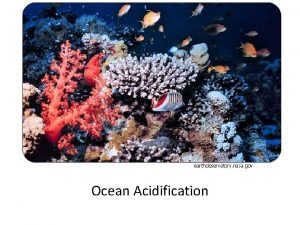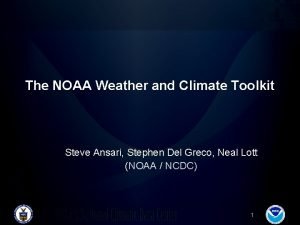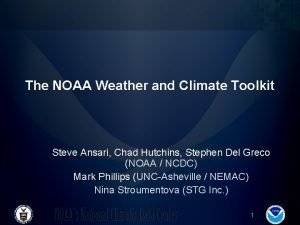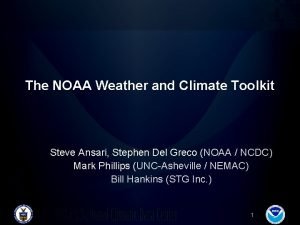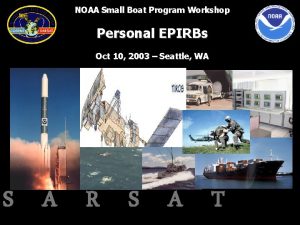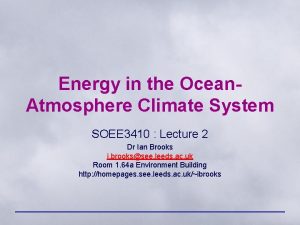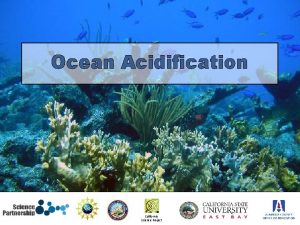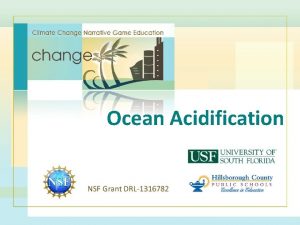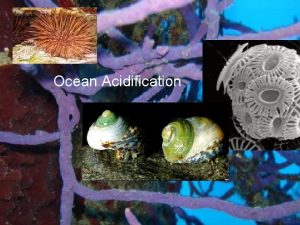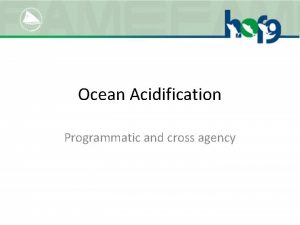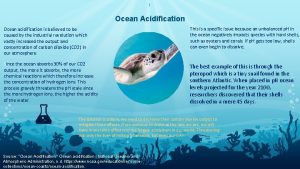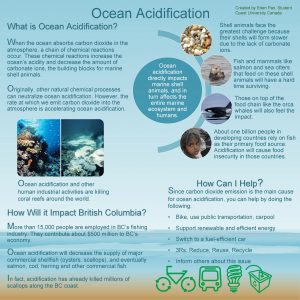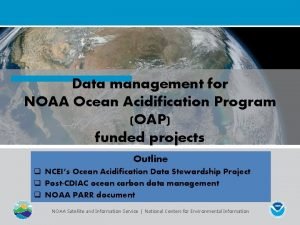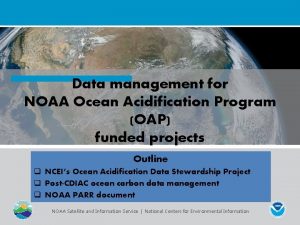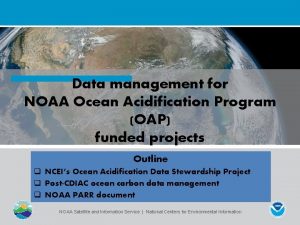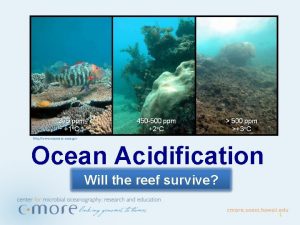NOAA Ocean Acidification Program Presented at Ocean Climate













- Slides: 13

NOAA Ocean Acidification Program Presented at : Ocean Climate Observation 8 th Annual PI Meeting June 2012 Presented by: Dr. Christopher Sabine Director, PMEL Image courtesy NOAA PMEL http: //www. pmel. noaa. gov/co 2/story/Ocean+Acidification

Federal Ocean Acidification Research and Monitoring (FOARAM) Act of 2009 A NASA IWG - OA A NO USGS NASA FWS EPA BOEM DOS FOARAM ACT NSF NOAA NSF The NOAA Ocean Acidification Program (OAP) was established under SEC. 12406. of the Federal Ocean Acidification and Monitoring Act (FOARAM) to oversee and coordinate research, monitoring, and other activities consistent with the strategic research and implementation plan developed by the interagency working group on ocean acidification. NOAA Ocean Acidification Program (SEC. 12406) Foster, direct, coordinate: (A) interdisciplinary research to improve understanding of ocean acidification; (B) establish a long-term monitoring program for ocean acidification (C) research to identify and develop adaptation strategies for conservation of marine ecosystems; (D) educational opportunities exploring the impacts of ocean acidification; (E) national public outreach (F) coordination of ocean acidification monitoring and impacts research with other appropriate international ocean science bodies

NOAA Ocean Acidification Program Oversight Structure Executive Oversight Board OAR – Chris Sabine NMFS – Ned Cyr NOS – Paul Sandifer NESDIS – Margarita Gregg OA Program Working Group “NOAWG”

Ocean Acidification Working Group NOAWG Monitor Trends OAR Laboratory and OER Reps CRCP Rep National Marine Sanctuaries Rep IOOS Rep Model changes NMFS Laboratory Reps NCCOS/NOS Rep CRCP Rep OAR Laboratory reps Adaptation Strategies Sea Grant Rep Climate Program Office Rep Ecosystem Responses NMFS Laboratory Reps NCCOS/NOS Rep CRCP Rep Synthesize Data NODC/NESDIS Rep Data Expert All Laboratory Reps Outreach and Education OA Program Office Sea Grant Rep Internationally recognized OA expert

IWG - OA FOARAM ACT NOAA NSF USGS NASA Fish & Wild USDA EPA DOS NOAA OAP NASA NSF Overall Guiding Questions…. The research objectives detailed in the NOAA National OA Plan are guided by the following overarching hypotheses: • Hypothesis 1. Rates and magnitude of OA will vary across time, space, and depth as a consequence of local and regional geochemical, hydrological, and biological mechanisms. • Hypothesis 2. OA will change ecosystem structure and function. • Hypothesis 3. Heterogeneity in species-specific responses, local secondary environmental factors and regional considerations will confer a broad range of vulnerabilities that differ both locally and regionally among marine ecosystems.

OAP Thematic Focus Areas Changing ocean chemistry Biological/Ecosystem Response Socio-Economic Impacts Adaptation Strategies Educational Resources Data Management

National Program

Changing ocean chemistry West coast OA Observing Network PMEL PIs: Richard A. Feely, Christopher L. Sabine, Simone Alin, Adrienne Sutton, Gregory Johnson, Steve Hankin, Meghan Cronin, Christian Meinig, Russell Brainard (NMFS) Academic Partners: Jeremy Mathis (UA), Jan Newton (UW), Burke Hales (OSU), Jack Barth (OSU), Lauren Juranek (OSU), Uwe Send (SIO), Mark Ohman (SIO), Andrew Dickson (SIO), Robert Weller (WHOI), Eric De Carlo (UH) Collaboration and coordination across international, federal and state agencies is vital. Image courtesy NOAA PMEL http: //www. pmel. noaa. gov/co 2/story/Ocean+Acidification

Changing ocean chemistry THEME 1. Monitoring Trends Ø On the continental shelf and in Puget Sound undersaturated (W<1) low p. H (<7. 7) conditions are present during late summer months, most often in near-bottom waters. Ø The largest local respiration signals are found in Hood Canal and the Washington-Oregon coastal waters where local hypoxia due to respiration processes significantly add to acidification conditions in the late summer months. Ø In addition to the anthropogenic CO 2 uptake, upwelling and respiration processes are major contributors to the high p. CO 2 and low p. H, undersaturated bottom waters that are highly vulnerable to further acidification in the future, therefore there is a need for strong linkages with biological process studies. 2011 August – September

Changing ocean chemistry International Ocean Acidification

Data Management PIs: Dr. Krisa Arzayus and Dr. Hernan Garcia, NOAA/NESDIS National Oceanographic Data Center 1. Provides support to NODC and partner data providers to establish end-to-end scientific data management coordination. 2. Establish OA Data Stewardship System (OADSS) 3. Serve as NOAA OA data focal point OA Data Management Workshop 1. 2. 3. 4. 5. NOAA OAP led Seattle, March 2012 Multi - agency PIs and data managers Already bearing fruit as develop protocols for data sharing

NOAA-wide Implementation of OA Strategy • Oceanic and Atmospheric Research (OAR) – – – – • NOAA’s Fisheries Service (NMFS) – – • Species specific experiments on commercial or recreational fishery species or their food/prey including primary producers (NEFSC, NWFSC, AFSC) Coral reef research and monitoring (PIFSC) Building shared-resource mesocosm infrastructures (NEFSC, NWFSC, AFSC) Fishery Impacts modeling (NEFSC, NWFSC, AFSC) National Ocean Service (NOS) – – – – • OA Program Office (HQ) Observing, modeling and technology development (PMEL/AOML) QA/QC for laboratories/universities (PMEL/AOML) Coral reef research and monitoring (AOML) National Sea Grant College Program: extramural research, communication, extension (300+ agents) Climate Program Office: Office of Climate Observation and Carbon Cycle Program Earth System modeling (GFDL ) U. S. IOOS Program Office and Regional Associations: OA is one of the current seven HIGH priority observing foci Coral Reef Conservation Program Biogeochemical and Ecosystem OA Impacts Modeling– extramural program - FY 12 RFP (NCCOS/CSCOR) NCCOS Laboratories National Marine Sanctuaries: Research and outreach plans for sanctuaries National Estuarine Research Reserves: Adding p. H to monitoring programs Arctic Program National Environmental Satellite, Data, and Information Service (NESDIS) – – – NODC: Data Archives Coral Reef Watch Satellite sensing of phytoplankton blooms

The Ocean Acidification Program looks forward to a strong partnership with the Office of Climate Observations and hopes that they can continue to find synergistic ways to collaborate. Questions or Comments…
 Ocean acidification
Ocean acidification Ocean acidification
Ocean acidification Weather climate toolkit
Weather climate toolkit Noaa wct
Noaa wct Noaa weather and climate toolkit
Noaa weather and climate toolkit Climate change 2014 mitigation of climate change
Climate change 2014 mitigation of climate change Locator beacons
Locator beacons What impact does the ocean have on climate brainpop
What impact does the ocean have on climate brainpop Ocean atmosphere and climate
Ocean atmosphere and climate Ocean atmosphere and climate
Ocean atmosphere and climate Convergent boundary features
Convergent boundary features Ocean ocean convergent boundary
Ocean ocean convergent boundary Convergent boundary
Convergent boundary Ocean ocean convergent boundary
Ocean ocean convergent boundary

